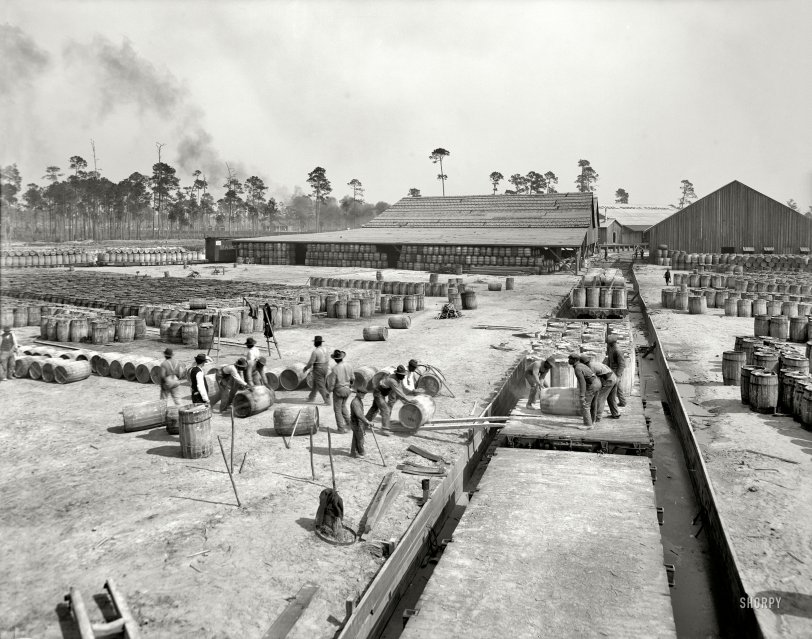


Framed or unframed, desk size to sofa size, printed by us in Arizona and Alabama since 2007. Explore now.
Shorpy is funded by you. Patreon contributors get an ad-free experience.
Learn more.

- Freeze Frame
- Texas Flyer wanted
- Just a Year Too Soon
- WWII -- Replacing men with women at the railroad crossing.
- Yes, Icing
- You kids drive me nuts!
- NOT An Easy Job
- I wonder
- Just add window boxes
- Icing Platform?
- Indiana Harbor Belt abides
- Freezing haze
- Corrections (for those who care)
- C&NW at Nelson
- Fallen Flags
- A dangerous job made worse
- Water Stop
- Passenger trains have right of way over freights?
- Coal
- Never ceases to amaze me.
- Still chuggin' (in model form)
- Great shot
- Westerly Breeze
- For the men, a trapeze
- Tickled
- Sense of loneliness ...
- 2 cents
- Charm City
- What an Outrage
- Brighton Park
Print Emporium
Railyard Rollers: 1905

Gulfport, Mississippi, circa 1905. "New Orleans supply yard, Union Naval Stores. Shipment of rosin and turpentine." 8x10 inch glass negative. View full size.
Turpentine Forests
Washington Post, Sep 15, 1902.Turpentine Forests.
Their Rapid Destruction Threatens the Ruin of a Great Industry.
From the New York Commercial.
The first organization of turpentine men, known as the Turpentine Operators and Factors' Association, which recently held its first annual convention in Jacksonville, Fla., was confronted by the question of complete annihilation of their business, due to the ruthless tapping of young trees and the rapid depletion of the pine forests. Ten years ago Norfolk, Va., was the great naval stores port of the United States, five years ago Charleston was the center of the industry, two years ago Savannah, and now Jacksonville, and next Tampa and then — what? Prof. Herty, of the United States Department of Forestry, has been called upon and was present at the convention.
Newspapers in the South have presented able articles on this same subject for years, but the writer has seen young trees no thicker in diameter than eight inches boxed; once, twice, yes three times, so that a step ladder was used for the top boxing and the strip of bark left was insufficient to gather the sap to feed the tree. The life of a turpentine tree after the first boxing is about two years. That means that after the sap has been taken the third time the tree must either be cut for timber or it dies. A trip through the pine forests of Georgia and Florida will demonstrate the reckless manner in which the boxing has been done, and, worse still, where clearings have been made, no effort has been made to check the growth of scrub oak and saw palmetto which effectually choke the young pine rearing its head where its parent stood. Gradually the operators have been driven south, and to-day it is estimated that at least one hundred camps are located in Florida alone, and about fifty camps in Georgia.
Nine hundred operators were at the convention. Each man has either bought or covered with options more or less pine forest, and in spite of his knowledge of what the future will bring is rapidly killing the goose with the golden egg. The end is near in the turpentine and rosin industry. A few more years will see a tremendous rise in these commodities, and no effort has yet been made to restore the depleted forests of Virginia, Georgia, Alabama, North Caroline, or Northwestern Florida. The "fat pine" is indigenous to these States, it grows rapidly, but is easily exterminated by the more sturdy plants which spring up in the forest clearings.
As far as the eye can see
Just how many hundreds of thousands of barrels of rosin and turpentine could possibly be needed? And for what purpose, painting?
[Used in the manufacture of soap, paper, paint and varnish. More on the "naval stores" industry, and the origin of the term. - Dave]
Safety first
The bridges over the rail trench are noticeably lacking proper railings. 1 safety demerit!
WWWaaa - ter boo-ooyyy
Bring the buck-buck-bucket here!
I remember that song so well, I could hear it in my mind when I saw this detail.
Never thought abut how rail cars wereloaded by hand before. The sunken rails, two men on a barrel, wooden rails to roll them on, all fascinating!

Even the Lionel Lines
1950s model barrel loader was more mechanized than this.
Hard labour
for those guys. It looks hot after maybe some recent rain, the barrels sure look heavy and there's a few hours left yet. Looks like there's refreshments being bought over by the youngster on the right.
Thanks for the info Thad, I never knew about turpentine's origin such as shown above.
Lunchtime
There appears to be a lovely young lady bringing some lucky gentleman his lunch bucket, and much prestige from his comrades.
Can't get enough turpentine photos!
The gum naval stores industry as practiced before WWII is now mostly forgotten, but was once a Really Big Deal in the longleaf pine belt that stretched from North Carolina to the Gulf coast of Texas. Sadly, most of the longleaf pines are gone now, and several species dependent on the pine forests-- for instance, the ivory-billed woodpecker-- are gone for good.
Those barrels would have been made and filled with turpentine and rosin distilled in small batches at camps located way out in the piney woods, by men working under absolutely medieval conditions. The ones working to pay the company store were lucky compared to the ones who were convicts leased from local law enforcement.
I've seen most of the more widely available turpentining images, but this is a new one on me-- thanks for running it, Dave.

























On Shorpy:
Today’s Top 5